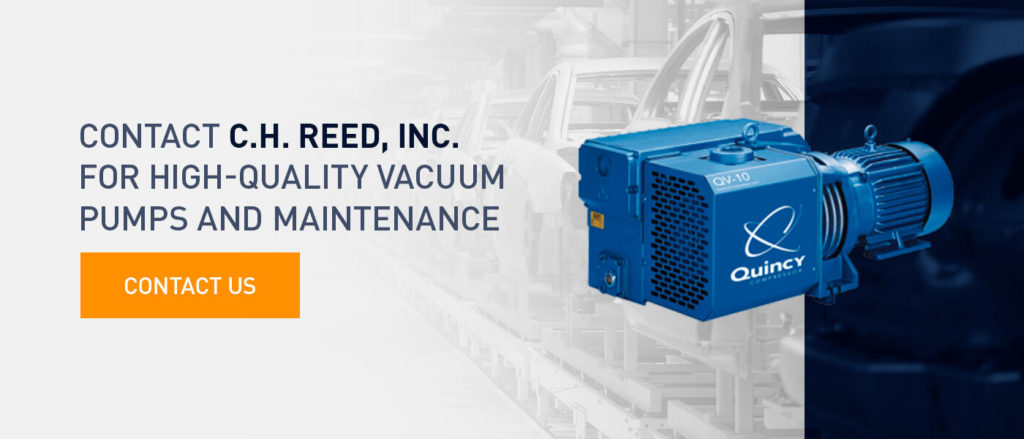August 2, 2021
Guide to Vacuum Pumps
SHARE THIS POST
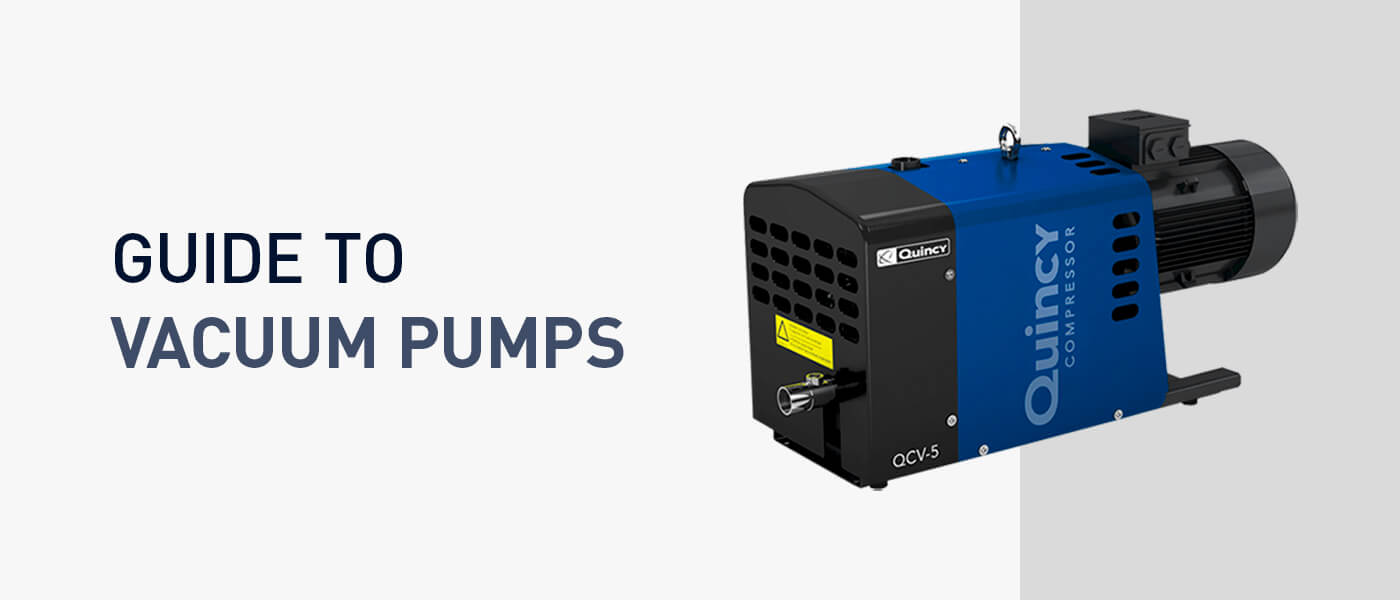
Vacuum pumps remove gasses from a constricted or confined space, creating a vacuum to complete a variety of tasks depending on the industry or application. Vacuum pumps are often used in industrial, research or manufacturing operations when a clean environment or pressures below atmospheric levels are needed. There are many different vacuum pump technologies and sizes available, from dedicated pumps for specific machines to centralized systems that can cover a whole facility.
Below, we’ll help you understand the use of vacuum pumps and how the different types of pumps work. Use our guide to learn what a vacuum pump does, how they’re used in various industries and why it’s important to keep up with their maintenance.
What Are Vacuum Pumps?
A vacuum pump is a piece of equipment that draws air and other gas molecules in from one sealed chamber to the next by changing high and low-pressure states. As molecules are continuously removed, it becomes more difficult to remove additional ones, which indicates a stronger vacuum and requires more work from the vacuum pump to decrease the pressure in the vessel.
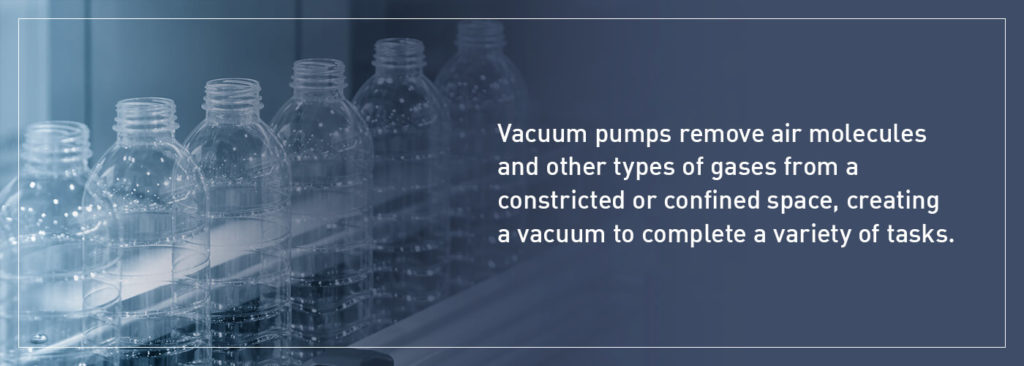
While different vacuum pumps are used depending on the application, they all create a vacuum effect that helps a system complete a given task.
Types of Vacuum Pumps
There are several different types of vacuum pumps, and each will work best depending on how well you maintain your pump, the environment you’re using it in, and what you’re using it for. Some of the most commonly used vacuum pumps include:
- Liquid ring: Liquid rings operate using a liquid, typically water. An impeller with an axis eccentric to the housing rotates the liquid, spinning the liquid out towards the impeller housing. This offset rotation and force result in a liquid ring, which is where this pump gets its name. Air and other gasses get sucked in as the space between the impeller and the ring expands, and as the impeller rotates, the molecules get compressed, where the gas is then expelled. This type of pump is common in environmental, textile, mining and chemical industries because of its air-purifying properties and commonly comes in one- and two-stage variants.
- Articulated piston: An articulated piston pump works much like that of a car engine. When the piston moves down, air and gasses are pulled into an intake valve. When the piston moves back up, the air molecules are pushed out the exhaust valve. Piston pumps can use one or more pistons to move air. They are well-suited for applications that require high suction and flow rates.
- Claw: Claw vacuum pumps use two continually rotating rotors that never come in contact with each other. This rotation moves gasses and air from the intake side to the output side, pulling vacuum. These vacuum pumps are popular in the medical field because they are oil-free, eliminating the possibility of contamination.
- Rotary vane: Rotary vane pumps use offset rotating vanes in a cylindrical case to create positive displacement. As the vanes move around the eccentric rotor, air and gas molecules get trapped between the vanes and are moved from the inlet to the outlet port, creating a vacuum. This type of pump is used in a range of industries like medical, environmental, food processing and air conditioning systems.
- Rotary screw: Rotary screw pumps also use positive displacement to create a vacuum. Two spiral-shaped rotors rotate in opposite directions. The opposite rotations trap air and create compression to move the molecules to the discharge port. Rotary screw vacuum pumps are often used in industrial applications that handle clean gasses.
- Diaphragm: Diaphragm vacuum pumps use positive displacement to move air and liquid. Two flexible walls move back and forth, forming a vacuum. The diaphragm walls’ motions simultaneously push and pull air and liquid in and out of the pump. These pumps are highly resistant to corrosion and are commonly used in the food industry, cosmetic industry and chemical industry.
- Scroll: Scroll vacuum pumps compress gas and liquid through the use of two spiral-shaped scrolls. One spiral is stationary, and the other spiral rotates around it eccentrically, creating pressure that compresses the gas and liquid particles. This type of pump can be found in mining, pharmaceutical and environmental industries.
How Do Vacuum Pumps Work?
When you hear the word vacuum, you probably associate it with a sucking force. Instead, vacuum pumps use high- and low-pressure areas to create a vacuum effect. Gasses want to equalize pressure across connected areas, so the high-pressure gasses will push their way into the low-pressure area.
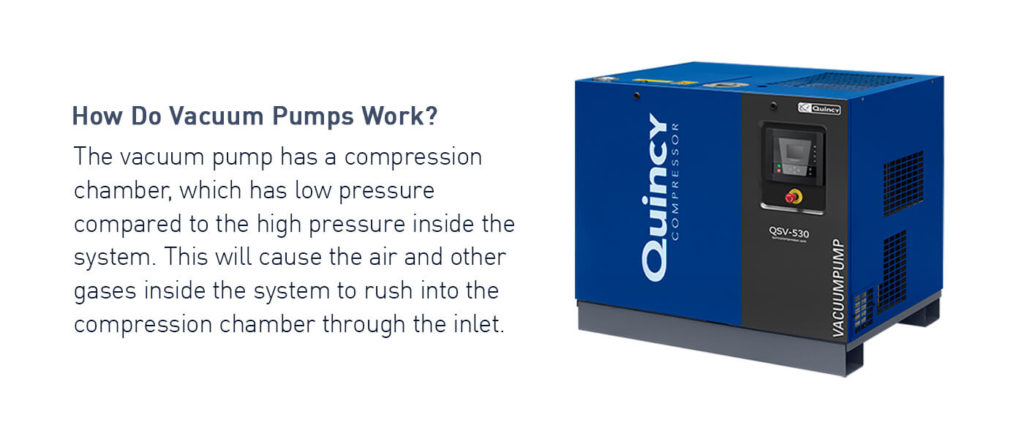
Let’s break it down more specifically. Vacuum pumps are connected to the system via an inlet. The vacuum pump has a compression chamber, which has low pressure compared to the high pressure inside the system. This will cause the air and other gasses inside the system to rush into the compression chamber through the inlet.
The compression chamber is basically split into two low-pressure areas that rotate, depending on the pump type. Once the first space fills up, the chamber rotates to compress the gasses into a smaller area, increasing the pressure and temperature on one side while letting more gas into the second space. This rotation continues until the pressure gets high enough to force a valve open, releasing the gasses. The compressor continues to rotate, allowing more air and gas in, compressing it and releasing it.
Vacuum pumps are used to remove air and other wet gas and vapor particles from a system. Without a vacuum pump, these particles can cause a system to run inefficiently and can even corrode internal parts. Generally, the purpose of a vacuum pump is to clean and seal an area from the air or other gasses. Vacuum pumps are often used wherever gasses and other particles need to be moved.
The most common uses for vacuum pumps include:
- Preserving Applications: A vacuum pump can assist with cooking, packaging and freeze-drying foods to prevent spoilage, enhance flavor and improve safety.
- Forming & Shaping Applications: Vacuum pumps are useful in vacuum forming, a simplified version of thermoforming often used by original equipment manufacturers when producing identical components. Auto parts manufacturing is a typical example.
- Holding, Lifting, & Moving Applications: These pumps can assist with gently moving parts from one location to another. The applied suction can also hold a part or object firmly and lift it if necessary.
- Creating Clean, Controlled Environments: Some types of vacuum pumps are commonly used in cleanrooms for industries like pharmaceuticals, food and ultrapure water processing.
- Degassing & Deaerating Applications: Mining, metals and building materials are examples of industries and applications that use vacuum degassing to strengthen their products. Removing excess gas helps prevent structural failures and ensures reliable, uniform products.
- Distillation Applications: Vacuum pumps for distillation help lower the boiling point of liquids, increasing the process’s efficiency. The pumps create lower pressure that facilitates the condensation and evaporation of vital components.
- Cooling & Drying Applications: Some types of vacuum pumps can assist with removing moisture and reducing temperatures in specific industrial, manufacturing and processing applications.
Assessing the Benefits of Vacuum Pumps
Utilizing pumps in your business processes can provide several advantages:
- Enhanced efficiency: These pumps help create the most appropriate environment for various work processes, enabling you to achieve faster, more precise results. High-performing pumps can also conserve energy.
- Better product quality: By creating a vacuum in an enclosed area, these pumps can significantly reduce or eliminate potentially detrimental forces like contamination and oxidation.
- Cost savings: Using vacuum pumps enables businesses to complete more projects faster and with fewer resources. High-quality pumps also require less preventive maintenance and repair service. When combined with their energy-efficient operation, they can lead to lower operating costs.
- Environmental benefits: In some cases, vacuum pumps can eliminate the need for hazardous chemicals in industrial processes, contributing to a healthier environment.
Industries Using Vacuum Pumps
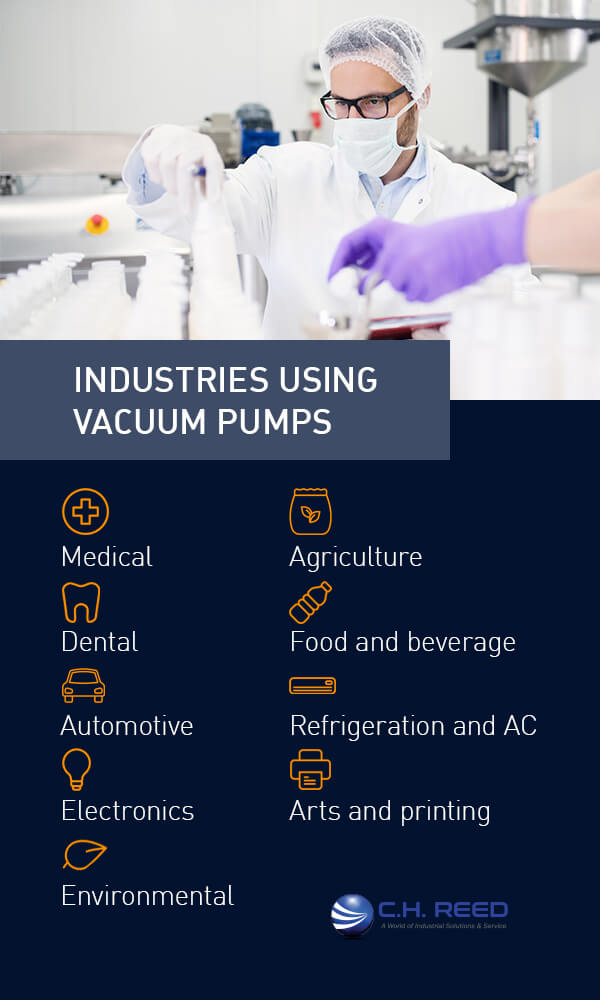
- Medical: The medical field uses vacuum pumps in a wide range of applications. Respiratory therapy equipment like various types of ventilators and oxygen concentrators use pumps. Surgical teams use vacuum pumps to power sterilization systems and other types of equipment. Other medical uses include using vacuum pumps to power breast pumps and suction units.
- Dental: Like the medical industry, the dental industry also uses vacuum pumps for various applications. Vacuum pumps in portable dental equipment and dental compressors build pressure to power the systems. Additionally, various dental devices are molded using a vacuum oven.
- Automotive: The production, maintenance and function of a vehicle rely on vacuum technology. Vacuum systems maintain vehicle suspension systems and cable pressure. Vacuum pumps are also used to build pressure for tire inflation and automotive detailing equipment.
- Electronics: Various electronics need vacuum pumps to function. For example, a light bulb needs a vacuum pump to be manufactured. Vacuum pumps can also be used in the production and assembly of electronics.
- Environmental: Environmental industries use vacuum pumps to power air sampling and soil aeration equipment and processes. Air supply systems and sewage aeration systems also heavily rely on vacuum pumps as a part of their operation.
- Agriculture: Vacuum pumps are found in the agriculture industry, too. They help power the development and application of agricultural sprays like pesticides. Crop sprayers and other field equipment also use vacuum pumps. Automatic milking equipment for cows, goats and other animals often uses vacuum technology to operate as well.
- Food and beverage: Whether it’s aerating, mixing or packaging, vacuum pumps are widely used in food and beverage manufacturing. Vacuum pumps are essential parts of the food processing and water purification processes. One of the biggest functions of vacuum pumps in this industry is to seal air-tight packaging. Manufacturers of vacuum-sealed products rely on vacuum pumps to keep their food fresh and meet regulatory requirements for food safety.
- Refrigeration and AC: Vacuum pumps are used in HVAC systems like air conditioning units and even refrigerators. The pumps are used to remove air and moisture that will damage the system. They’re also used for evaporating refrigerant, thereby lowering the temperature of whatever is being cooled while increasing the temperature of the refrigerant. The vacuum prevents lines and tubing from getting clogged with contaminants.
- Arts and printing: Many automatic printing and art equipment systems use vacuum pumps to operate. Projects and artists that use framing equipment, airbrushes, ink-jet printers and other pieces of art equipment rely on vacuum pumps’ pressure.
More specific applications where vacuum pumps are used include composite molding, aviation, paper manufacturing for consumer packaged goods, form shaping, labs & schools, CNC routers, and other industrial manufacturing industries.
Importance of Vacuum Pump Maintenance
For utmost reliability, routine maintenance should be conducted on your vacuum pumps, regardless of the type. Routine maintenance helps prevent vacuum pumps from breaking down, which would result in costly emergency repairs and process disruption. Taking care of these components will help increase their longevity and can ultimately save you money in the long run. While some maintenance can be done in-house, you may want to consider hiring a specialist to ensure proper maintenance.
Timely vacuum pump maintenance will also keep your equipment performing at its best. You’ll maintain your tight production schedules and meet your customers’ demands, giving your company a competitive edge.
Change the Oil Regularly
Although new technologies with vacuum pumps, like Quincy Compressor’s QSV Rotary Screw Vacuum Pump, has less oil carryover than older pumps, oil contamination is one of the biggest areas of concern for pump maintenance. Vapors and moisture can contaminate the oil, reducing its lubricity and overall effectiveness. Oil also naturally deteriorates over time. While routine oil changes may be time-consuming and interrupt your processes, it’s one of the most important areas of maintaining your vacuum pump.
How often you need to change your pump’s oil will depend on the pump itself and how often you use it. It’s best to consult the manual that came with the pump, as it will provide information about maintenance schedules. Remember that the manual is merely a guideline — oil changes may need to occur sooner, depending on the type of application. It’s also vital to use the recommended oil, as other types can result in off-gassing, contamination, performance degradation and ultimately unit failure.
Monitor the oil yourself. Your pump’s oil should be lightly colored and mostly clear. When the color starts getting dark, it’s time to replace your oil. You should also change the oil if it appears cloudy or milky. This can indicate a leak in your system, so it’s important to drain the oil and check the system for leaks.
Internal Inspection and Cleaning
Another part of routine maintenance includes dismantling your pump and inspecting the individual parts. This measure should be done every 3,000 hours of operation or more often, depending on the level of use. Inspect the belts to ensure they’re free of oil, as this could indicate a leak. Replace belts that show signs of cracking or rubbing against other parts.
Vanes, bearings, belts and casings should all be inspected for cracks and general wear and tear and should be replaced as needed in sets. Check for deposit buildup and contamination. When you’re finished inspecting, take time to clean the parts. This reduces the chance of contamination and keeps the parts of your vacuum pump in an overall good condition to ensure your pump continues to operate efficiently. Of course, you could also hire professional services to complete all those steps efficiently.
Changing Damaged Components
Your vacuum pump maintenance steps may reveal worn or damaged parts that are not directly impacting the equipment’s performance. However, not upgrading these components immediately could eventually affect the functioning of other systems and cause an unexpected mechanical failure. Completing this step promptly can also be more cost-effective, as it could prevent a costly repair job or an earlier-than-anticipated machine replacement.
Do a Test Run
Conducting a test run on your pump is an effective way to ensure everything is operating properly and safely. It’s also important to compare pump performance before and after maintenance, as significant differences between the two could indicate improper reassembly, part failure or other issues. Run the vacuum pump and listen for any abnormal noises that may indicate damage or leaks. Ensure the pump is operating at a safe temperature to reduce the chances of overheating. This aspect of maintenance is essential, especially if your pump has been sitting for a few months. Turn it on to ensure it will operate correctly after its break.
Additional Maintenance Tips
There are many aspects to remember when conducting maintenance checks. Remember to consult your pump’s manual for specifics. Consider these additional maintenance steps as applicable to your vacuum pump:
- Check exhaust and oil filters and replace as needed.
- Inspect water flow.
- Test fault or error alarms.
- Clean the intake dust filter.
- Inspect water hoses for cracks or other signs of damage.
- Check for oil, water and other leaks.
- Take readings of internal temperatures.
- Clean the fan cover.
- Inspect the surrounding area.
Contaminants are harmful to the safety and operation of your vacuum pumps, which is why it’s essential to commit to performing routine maintenance on your pumps. Keep detailed records of maintenance and inspection checks so the next person to look at your equipment can be updated on previous work done on the pump. It’s critical to keep up with vacuum pump maintenance to keep operations running smoothly and make sure your pump works to the expected standards. Vacuum pumps should always be serviced according to the manufacturer’s service recommendations.
Contact C.H. Reed, Inc. for High-Quality Vacuum Pump Solutions and Maintenance Services
Although keeping up with the maintenance of your vacuum pumps can be time-consuming, it’s necessary for the efficiency and longevity of your equipment. If your team lacks the time or expertise to perform pump inspections or maintenance, call C.H. Reed, Inc. We understand that you need your pumps to remain in good condition so your systems can keep running. For this reason, we provide high-quality vacuum pump maintenance services and repairs so you can keep your systems operating with minimal downtime.
If you’re looking for a vacuum pump solution, C.H. Reed is your go-to. With decades of experience, and sales and service locations throughout the mid-Atlantic region, we’re reliable experts on all things involving vacuum pumps and compressed air systems. Instead of guessing, put your system in our specialists’ hands. We’ll get to know you and your needs, goals and objectives. Doing so allows us to find you the most effective vacuum pump solution or vacuum pump maintenance plan for your systems.
To learn about our products and services, contact C.H. Reed and speak with a specialist today.
Search
Categories
Get a consultation
Related Posts
The 3 Distinct Advantages of Hydraulic Powered Pumps
Recently, C. H. Reed helped a major printing operation install a new ink pumping system. The new system needed to transfer four colors of high viscosity, heat-set ink to their three presses, drawing the ink from multiple 5,000…
Simple Ways to Reduce Waste in Your Spray Finishing System
In today’s demanding manufacturing landscape, it can be convenient to adopt a “cut-costs-at-all-costs” mentality, justifying questionable means for the sake of leaner production, a lower bottom line and increased profitability. Regrettably, those efforts can interfere…
What You Need to Know About Air-Powered Pressure Washers
Pressure washers are great solutions for your average cleaning applications, but what tool do you turn to for your more challenging applications? There are many instances where it is simply impossible to use a traditional…
